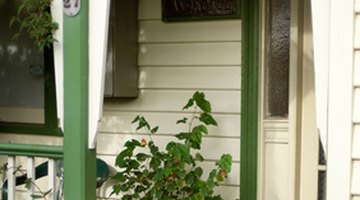Building Codes for Porch Enclosures
A porch creates an intermediate space between the indoors and an outside yard or garden; it provides more shelter than a simple deck, and in colloquial usage, it often refers to structures at the front of the house, unlike backyard or interior patios. Building codes address all structures, attached or detached from the primary home, commonly referred to as porches. The International Building Code defines the enclosure requirements for patio covers and state and municipal codes and ordinances provide further requirements. Check with your local authorities to determine that your porch meets the relevant criteria for your area.
IBC Regulations

The International Building Code, or IBC, defines any one-story structure of maximum 12 feet tall, attached or detached to a home, with over 65 percent of its enclosure walls open or glazed, to be a patio enclosure. This definition includes many of the structures colloquially referred to as porches. According to the code, such structures must be used for recreational purposes, not for habitation or as carports or storage rooms. The IBC allows patio (and porch) enclosures to use screening, glass or approved translucent or transparent plastics. Plastics material cannot measure more than .125 inches wide. The IBC also requires that porch enclosures sustain minimum dead loads, or constant forces such as the weight of the structure, and minimum live loads, such as intermittent forces from wind and snow. In addition, porch enclosures must stand up to seismic and wind forces equal to the requirements on all exterior structures.
Local Codes
Many local codes and ordinances follow the regulations of the International Building Code, though some adopt state codes or impose further addenda, especially on matters of aesthetic standards or historical conservation. The City of Escondido, California, for example, imposes very similar regulations as the IBC. However, the city-wide code additionally requires smoke detectors in certain cases, imposes a minimum ceiling height and requires compliance with the California Electrical Code. In addition to safety regulations, zoning laws on porches may also highlight a specific kind of building or facade style; in Spokane, Washington, "cottage housing units," a type of smaller, single-family housing, must be oriented around covered porches. The covered porch must measure at least sixty square feet and be at least six feet across on its shortest side.
OSHA Regulations
As porches often serve as means of egress, or emergency exits, their design falls under the regulation of the Occupational Safety and Health Administration whenever they are featured in workplace environments. For businesses with employees, run out of converted homes, these guidelines apply particularly. Should the porch fall along a designated exit route, it counts as part of the interior route, and is counted when determining the route's total distance to open space. The porch enclosure must meet requisite exit route dimensions, measuring at least seven feet six inches high and 28 inches wide at all points.
References
Resources
Writer Bio
Danielle Hill has been writing, editing and translating since 2005. She has contributed to "Globe Pequot" Barcelona travel guide, "Gulfshore Business Magazine," "Connecting Lines: New Poetry from Mexico" and "The Barcelona Review." She has trained in neuro-linguistic programming and holds a Bachelor of Arts in comparative literature and literary translation from Brown University.
Photo Credits
- front porch image by Steve Lovegrove from Fotolia.com
More Articles



